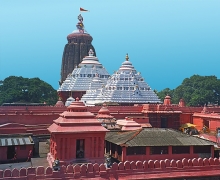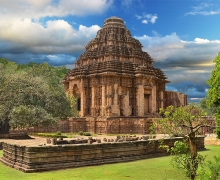
India is a land of spirituality and faith. The general population here has profound confidence on Almighty and their religion. It is a land of festivity and every state of its has major festivals of their own. These celebrations are special and hold much significance.
The celebrations are seen with fervour and magnificence. To know the genuine nature of India and concept behind the celebrations one should visit India at the season of celebrations, when the nation have an alternate viewpoint, when the general population gets enjoyed offering supplications and stay cheerful.
Thursday denotes the main day of the yearly Jagannath Rath Yatra, which is a 10-day celebration in Odisha, to stamp the adventure of the three divinities — Lord Jagannath, Lord Balabhadra and Devi Subhadra — to the sanctuary of their 'auntie', Devi Gundicha. The event is additionally called the "chariot celebration".
PURI: A sea of devotees gathered at the beach town of Puri in Odisha for the annual nine-day Jagannath Rath Yatra. Every year the Rath Yatra or the journey begins from the Jaganath Temple of Puri. Lakhs of individuals joined in Puri for a look at Lord Jagannath, Lord Balabhadra and Devi Subhadra on the Bada Danda (Grand Road) as they head out from their home to the Shree Gundicha sanctuary, home of their auntie. The divinities will head out to Gundicha sanctuary on three goliath wooden chariots - Nandighosa (Lord Jagannath), Taladhwaja (Balabhadra) and Darpadalan (Subhadra) - to be pulled by the gathered devotees.
This religious celebration is gone to by a great many lovers and voyagers from over the globe in Jagannath dham Puri. It is accepted that going to the Rath Yatra is a gateway to paradise. It is either held in the long stretch of June or July consistently.
The symbols are shipped on transcending chariots, which have been made to look like sanctuaries, giving the celebration its name of Ratha Yatra - the Chariot Festival. Around one million explorers more often than not rush to this beautiful occasion.
A few interesting rituals are included with this celebration. The most significant piece of the ritual is Chera Pahara, where the road must be cleaned by Gajapati King with a brilliant took care of floor brush then just the chariots arrive. At that point the service of Pahandi Vijay starts, where the diminutive person types of the divinities are introduced on these tremendous and flawlessly enlivened chariots. The Yatra of the Chariots at that point starts from the primary gateway Singhdwara (the Lion's Gate) to the principle goal (Gundicha Temple).
What Rituals are performed During the Festival?
Brahma Paribartan
The primary topic of the celebration is rebirth. To symbolize rebirth, the temple’s old icons are crushed and new icons are initiated. The production of the new idols is an interesting ritual, without anyone else's input. The icons are made via cutting neem wood. During this designing, Vedic prayers and melodies are recited from outside the territory. When they are finished, the icons are taken into the inward sanctum of the sanctuary. The parade of reciting will pursue the icon. The old icons are put before the new symbol, up close and personal. At that point, reciting and prayers are performed to transfer the supreme power of the old icon into the new one.
This ritual is done in sheer security. Indeed, even the priest playing out the ritual will be blindfolded. His hands and legs will be wrapped with material so he won't detect the exchange. This ritual is called as the Brahma Paribartan, which means changing of soul.
Koili Baikuntha Burial
When this ritual is finished, the new symbol is initiated into the position of royalty. The old icon is then taken to the Koili Baikuntha. After a sacred function, the old icons will be covered. This ceremony occurs before first light. It is said that if any everyday citizen sees this ritual, it would be lethal. Just the clerics who play out this custom could observer it. To maintain a strategic distance from everyday citizens entering the sanctuary, the state government will issue a total power outage in Puri during the evening of the internment. After the entombment function, the lights will be exchanged on. Afterward, flowers, foods will be served to the god and love ceremonies will begin.
Chariot Procession
During the celebration, the new icons will be taken out on a parade on a huge chariot. This chariot travels through the avenues of Puri from the Royal Palace closer to Jagannath Temple. On the off chance that you are keen on the chariot construction celebration, you should visit Puri during Akshaya Tritiya.
Ritual Bath (Snana Yatra)
18 days preceding the celebration, the symbols will be given a custom shower with 108 pitchers of crisp water. This custom is called as Snana Yatra. This service happens on the full moon day of Jyeshtha month. It is a conviction that the symbols would feel unwell after the shower and the icons are avoided people in general until the Ratha Yatra celebration.
After the chariot ride around the city, the icons are come back to the sanctuary. They are improved with gold adornments and are put inside the sanctuary. Afterward, a comic order is organized. As per mythology, the Goddess Laxmi is irate that the God left the temple without informing her and will close the gates of the temple, making the God stuck outside. God will plead for her forgiveness with desserts and songs and she gives him access.
Important Ratha Yatra Ritual Dates for 2019
Sri Gundicha July 4: Placement of the divinities in the chariots and journey to Gundicha Temple. The principal chariot to move is that of Lord Balabhadra. Next is Subhadra's, and last Lord Jagannath's. Pulling of the chariots begins at 4 p.m. after the significant customs have been finished.
Hera Panchami July 8: Goddess Lakshmi, the spouse of Lord Jagannath, gets concerned in light of the fact that he hasn't return. Aggravated, she goes to Gundicha Temple to discover him and see what's happening. Aficionados convey the divinity in a palanquin to the sanctuary.
Bahuda Yatra July 12: The fabulous return adventure to the Lion's Gate passageway of Jagannath Temple. Ceremonies occur from early afternoon to 2 p.m. The chariots are attracted invert request, initiating at around 4 p.m.
Suna Besha July 13: Decoration of the gods in gold trimmings. This ceremonial was presented during the reign of ruler Kapilendra Deb in 1430 and is especially famous. It occurs at night, from 5 p.m. to 11 p.m.
Niladri Bijaya/Bije July 15: Deities are put back inside Jagannath Temple.
Interesting Information about Lord Jagannath
The symbol of Lord Jagannath doesn't have any arms and legs. Do you know why? Obviously, it was cut out of wood by a craftsman after the Lord went to the King in a fantasy and taught him to get the idol made. In the event that anybody saw the symbol before it was done, the work would not advance any further. The King ended up eager and took a look, and the icon stays fragmented. A few people say that Jagannath's blemish communicates the flaw surrounding us and that it's a suggestion to be caring to the individuals who are not the same as us.


- Puri, Bhubaneswar, india
- Inclusion:





- INR :10465/- pp

- Puri, Bhubaneswar, Gopalpur, india
- Inclusion:





- INR :19486/- pp

- Bhubaneswar, Chilika, Gopalpur, Puri, india
- Inclusion:





- INR :25771/- pp


